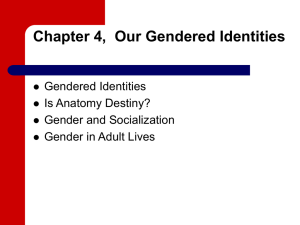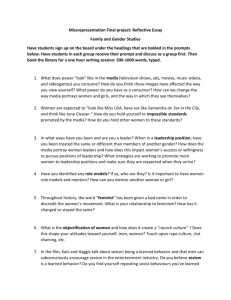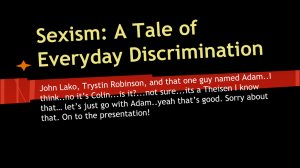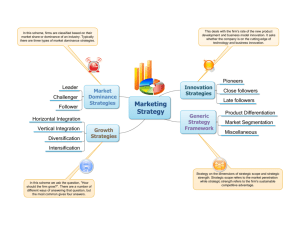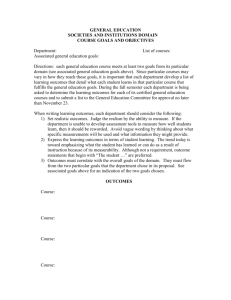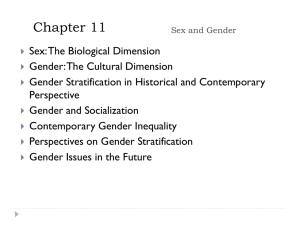Chapter 4, Our Gendered Identities
advertisement
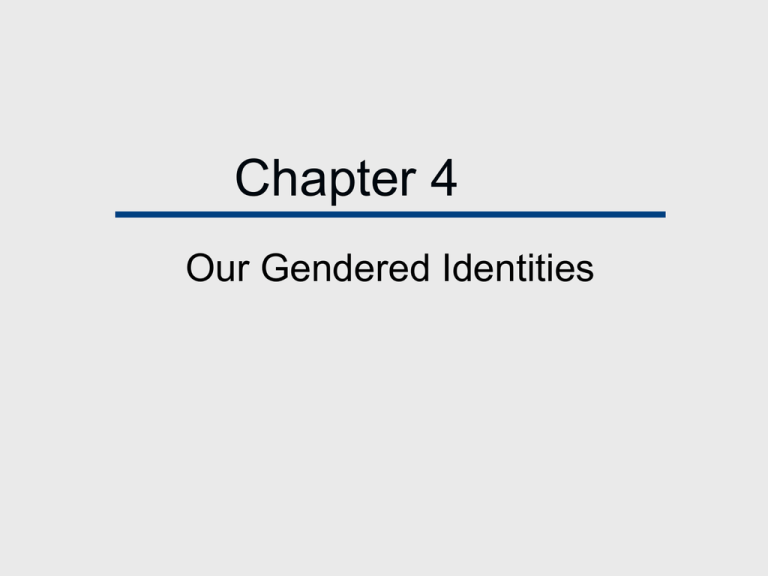
Chapter 4 Our Gendered Identities Chapter Outline Gendered Identities Is Anatomy Destiny? Gender and Socialization Gender in Adult Lives Sexism Traditional sexism is the belief that women’s roles should be confined to the family and that women are not as fit as men for certain tasks or for leadership positions. Modern sexism denies that gender discrimination persists and includes the belief that women are asking for too much—a situation that results in resistance to women’s demands. Gender and Sex Sex includes the chromosomal, hormonal, and anatomical components of males and females. Gender describes societal attitudes and behaviors expected of and associated with the two sexes. Gender identity refers to the degree to which an individual sees herself or himself as feminine or masculine based on society’s definitions of appropriate gender roles. Masculine “Scripts” 1. 2. 3. 4. No sissy-stuff - men are expected to distance themselves from anything feminine. Big wheel - men should be occupationally or financially successful. Sturdy oak - men should be confident and selfreliant. Give ‘em hell -men should do what is necessary to “make it”. Femininities Women should offer emotional support. Ideal woman is attractive, not too competitive, a good listener and adaptable. Women are expected to be good mothers and put the needs of others first. Superwoman - successful at a career and a good wife/mother. Traits in Men and Women How females and males differ on height. Averages by sex, but trait distributions occupy much common ground. Male Dominance A situation in which males assume authority over the female. On the societal level, male dominance is the assignment to men of greater control and influence over society’s institutions. There are no known societies where women dominate men. Male Dominance Research shows that: On an interpersonal level, males in groups tend to dominate verbally. Men talk louder and longer, interrupt other speakers, and control conversational topics more than women. Females restrict themselves more in claiming personal space, smile more when smiling is not related to happiness, and touch others less in groups, but are touched more. Male Dominance In Politics Before 1992, there had never been more than two women among our 100 U.S. senators. As of 2001, there were 13 women in the Senate and 62 in the House of Representatives; women compose 14% of Congress. Surveys report that 92% of the public say they would be willing to vote for a woman for president, compared to 53% thirty years earlier. Male Dominance In Religion Most U.S. congregations have more female than male participants, yet men hold more positions of authority. Women are prohibited from holding Catholic clerical or lay deacon positions. A majority of U.S. Catholic laypeople and theologians believe the Catholic church should ordain women priests, the Vatican disagrees. Male Dominance In The Economy In 2002, women who were employed full time earned 77% of what men earned. In 2000 in the highest paying occupation, that of physician, women made $80,000 while men earned $140,000 on average. Female professionals generally made 67% of what their male counterparts did in their longest held job. Women’s earnings in managerial occupations were 65% of men’s. Male Dominance In The Economy Men dominate corporate America. In 2000, 5.2% of the highest-earning executives in Fortune 500 companies were women. Racism blocks the path to management for nonwhite or Hispanic men, both racism and sexism block the path for nonwhite and Hispanic women, who hold only 1.3% of executive positions. Asian American women are most likely to have management or professional roles. Biological Theories of Gender In order to continue their genes, individuals maximize their own and their close kin’s reproduction. Men and women have different adaptive strategies and skills encoded in the genes. Male and female brains differ due to greater amounts of testosterone secreted by a male fetus. Biosocial Theories of Gender Stratification Biosocial theorists point to evolution, hormones, and behavioral genetics as influences on family-related behavior. Studies suggest that men with higher testosterone levels may be less likely to marry. If they marry, they may experience a lower quality of spousal interaction, be more likely to report hitting their wives, be more likely to have extramarital sex, and be more likely to divorce. Society Based Gender Stratification Structural constraints produce gendered behavior. Huber’s theory of gender stratification examines three stages that vary considerably in the roles and status assigned to men and women: Foraging and hoe societies Agricultural societies Industrial societies Foraging and Hoe Societies Food production is compatible with pregnancy, and nursing. Women fully participate economically so males are less dominant. Agricultural Societies Food production is less compatible with pregnancy and nursing. Men did the heavy work and women's productive labor was less visible. Patriarchy became established and increased the social control exerted over women. Industrial Societies Status of women declined as work became separate from home and family life. Women’s contribution to the economy through domestic support and reproduction of the labor force became virtually invisible. Interaction of Culture and Biology Biology and society probably interact to create gender-linked characteristics and roles. What’s happening in one’s environment may influence hormone secretion levels. Theories of Socialization Social Learning Theory Children learn gender roles as they are taught by parents, schools and the media. Self-identification theory Children categorize themselves by age 3 and identify behaviors in their families, the media and elsewhere that are appropriate to their sex and adopt these behaviors. Theories of Socialization Gender Schema Theory Children develop a frame of knowledge about what girls and boys typically do. Children's Theory of Gender Infants develop a primary identification with their primary caregiver and must differentiate psychologically and emotionally between themselves and their primary caregiver. Girls and Boys in the Family Parents handle infant sons more roughly and respond more quickly to baby girls. Most parents discourage their children from playing with other sex toys. Parents allocate household chores according to the child’s sex. Socialization in School's More men are in positions of authority (principals) and women are in positions of service (teachers and secretaries). Teachers pay more attention to males than to females. Males tend to dominate learning environments from nursery school to college. Gender and Stress: Women Women are oriented to others at the expense of self, leading to depression, boredom, and dissatisfaction. Suicide attempts are more common among women than men. Women have higher rates of mental illness and eating disorders. Gender and Stress: Men Overemphasis on production, competition and achievement create anxiety and stress which may contribute to shorter life expectancy. Physically dangerous behaviors (smoking, unsafe driving, drug use, violence) shorten men’s lives. Hiding their feelings can lead to hidden depression and isolation. Gender Differences in Life Expectancy at Birth 1900–2002 Quick Quiz 1. Jack believes that a woman’s “place” is in the home. Jack’s point of view is an illustration of __________ sexism. a) modern b) neo c) traditional d) post-modern Answer: c Jack believes that a woman’s “place” is in the home. Jack’s point of view is an illustration of traditional sexism. 2. Consider the statement: “Discrimination against women in the labor force is no longer a problem.” This reflects __________ sexism. a) neo b) modern c) traditional d) post-modern Answer: b The statement: “Discrimination against women in the labor force is no longer a problem.” This reflects modern sexism. 3. In which of the following religious categories are women prohibited from holding positions? a) the pastorate within Protestant Christian churches b) rabbis in Reform Jewish congregations c) feminist evangelicals d) Catholic clerical or lay deacon Answer: d Women are prohibited from holding positions in the Catholic clerical or lay deacon. 4. Biological theories of gender difference were initially offered by a) biologists. b) primatologists. c) zoologists. d) Geneticists Answer: b Biological theories of gender difference were initially offered by primatologists.
